Russia rising!
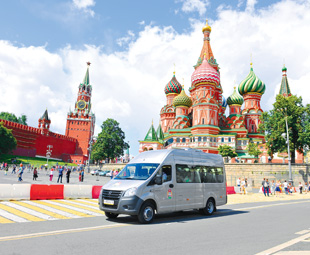
Russia is undoubtedly one of the most interesting – and challenging – commercial vehicle markets in the world. Home to over eight-million commercial vehicles, it’s currently experiencing off-the-chart growth. CHARLEEN CLARKE travelled to this fascinating country, where she attended Comtrans and visited key players – and she reports that this is a market unlike any other
Russia is a place of extremes, and so, too, is its commercial-vehicle market. The sales volumes vacillate constantly, moving from 104 540 truck sales in 2013 to just 48 260 in 2015. Over the same period, bus sales dropped from 14 700 to 8 220 while light commercial vehicle sales plummeted from 193 650 to 102 340.
The trucks in use within this vast country also demonstrate this extremity; they range from very old trucks that look as though they need to be in a museum (every other truck on the roads is over 15 years old) to extremely modern vehicles that would not look out of place in western Europe. Operating conditions vacillate too – from typical long-haul applications to extreme operating conditions (temperatures often drop to below -38°C in the north-eastern regions around Jakutsk).
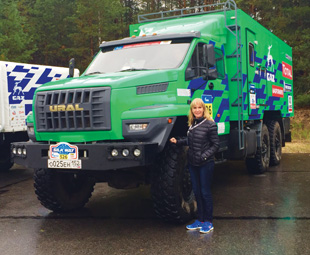 This is not a market for the faint-hearted. Until fairly recently, it’s also not been a massive market for the European truck makers … but, like everything else in the Russian truck industry, this is changing. Fast.
This is not a market for the faint-hearted. Until fairly recently, it’s also not been a massive market for the European truck makers … but, like everything else in the Russian truck industry, this is changing. Fast.
Back in the USSR
In order to understand the Russian market today, it’s necessary to backtrack a bit – to the days of the Soviet Union. As Andy Thompson, author of Trucks Of The Soviet Union: The Definitive History, notes, when the Communists raised the red flag over Russia in October 1917, they inherited a country with virtually no truck industry. Britain, Germany, America and France had factories mass producing trucks; the Russians had a few tiny assembly plants, bolting together imported components.
The Communist Party was determined to change this situation, and so it established its own truck manufacturers. Two of the biggest were GAZ and KAMAZ, which FOCUS visited in order to compile this special report.
The former was established in 1929, following an agreement between Henry Ford and Joseph Stalin, who was, of course, then ruler of communist Russia. Ford had no qualms about doing business with the communists. In fact, an article published in May 1929 in The New York Times quoted Ford as saying: “No matter where industry prospers, whether in India or China, or Russia, all the world is bound to catch some good from it.”
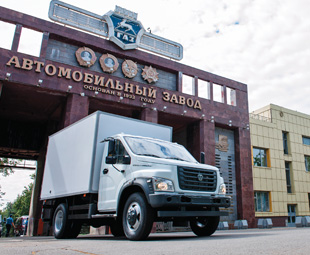 Ford caught a lot of good. In terms of this agreement, the company provided technical assistance to the Soviets who, in turn, bought vehicles and parts to the tune of a whopping
Ford caught a lot of good. In terms of this agreement, the company provided technical assistance to the Soviets who, in turn, bought vehicles and parts to the tune of a whopping
$30 million (roughly R405 million in today’s money). Initially, the company was known as Nizhegorodsky Avtomobilny Zavod – or NAZ, but then, when its first plant opened in the town of Gorky (now Nizhny Novgorod) in 1932, it was renamed to Gorkovsky Avtomobilny Zavod (meaning “Gorky Automobile Plant”). Ford sent Model A car and truck kits to the plant, which assembled what it called the GAZ-A and GAZ-AA respectively.
KAMAZ, on the other hand, was established in 1969, following a resolution by the Central Committee of the USSR Communist Party and the USSR Council of Ministers. Its name hails from the Kama River (KAMAZ was established in a tiny town called Naberezhnye Chelny, on its banks). The first KAMAZ truck rolled off the final assembly line on February 16, 1976. Largely thanks to the establishment of KAMAZ, the town has expanded, and today it’s home to about 524 000 people.
These two companies were able to enjoy a commanding share of the local market for decades. That market grew substantially, as Thompson notes: “The Soviet Union’s engineers, designers and workers created one of the world’s largest truck industries.” Truck sales were bolstered considerably by military purchases, which – especially during times of war – accounted for more than half of all purchases.
Soviet Union is no more
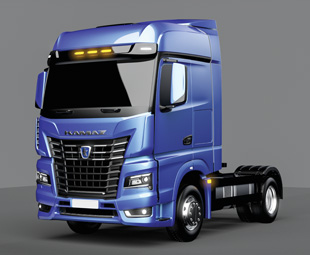 On December 25, 1991, the Soviet flag – with its hammer and sickle – was lowered for the last time over the Kremlin, signalling the end of the Soviet Union. Earlier that day, Mikhail Gorbachev had stepped down as president of the Soviet Union, leaving Boris Yeltsin as president of the newly independent Russian state.
On December 25, 1991, the Soviet flag – with its hammer and sickle – was lowered for the last time over the Kremlin, signalling the end of the Soviet Union. Earlier that day, Mikhail Gorbachev had stepped down as president of the Soviet Union, leaving Boris Yeltsin as president of the newly independent Russian state.
The European truck manufacturers sat up and took note.
Some European companies – notably the Swedish – had previously been present in the Russian market. Scania, for instance, had been active in the Russian market over 100 years ago, as Wojciech Rowiński, managing director of Scania Rus, reveals.
“The history of Scania’s presence in Russia began when the first service truck for tramlines was shipped to the Russian Empire in 1910. It was used in St Petersburg, which was then the capital,” he tells FOCUS. After the First World War. however, Scania was forced to stop its operations in Russia.
In 1993, Scania once again embarked on a journey to capture the Russian market. “Eight years later, we managed to make a dramatic leap forward with the launch of the Griffin series of trucks, which were highly appreciated by customers, thanks to their reliability, cost-efficiency and comfort. However, we didn’t just sell trucks, we also offered a ‘package’ of services, which was virtually unique to the Russian market at the time,” explains Rowiński.
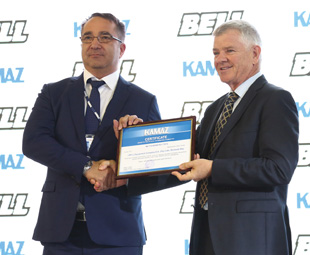 The “package” included the vehicle itself, which was tailored for Russia, especially in terms of road and economic conditions, maintenance and financing. The vehicles were configured to meet specific needs of Russian customers and were available on very favourable terms. Even today, Scania Griffin vehicles are common on Russia’s roads.
The “package” included the vehicle itself, which was tailored for Russia, especially in terms of road and economic conditions, maintenance and financing. The vehicles were configured to meet specific needs of Russian customers and were available on very favourable terms. Even today, Scania Griffin vehicles are common on Russia’s roads.
Scania has a plant in St Petersburg, which opened in 2010. It has an assembly capacity of 5 000 truck chassis and 1 500 superstructures per year. MAN opened a plant in the same city one year later. Last year, Scania and MAN joined forces, and their trucks are now produced in the same facility in
St Petersburg.
Volvo is another company with a long history in Russia; the brand was registered in the then Soviet Union in 1969 and the first 100 Volvo trucks were delivered to Sovtransavto Leningrad in 1973. In 2009, Volvo opened a plant in Kaluga, which is situated 200 km south-west of Moscow. It has an annual capacity of 10 000 Volvo and 5 000 Renault trucks.
Some other companies – Daimler, for instance – were slower coming to market. It was only in 2010 that Mercedes-Benz Trucks Vostok, a joint venture between Daimler and KAMAZ – was formed. At the same time, Fuso KAMAZ Trucks Rus – a joint venue between Mitsubishi Fuso Truck and Bus Corporation and KAMAZ – came into being.
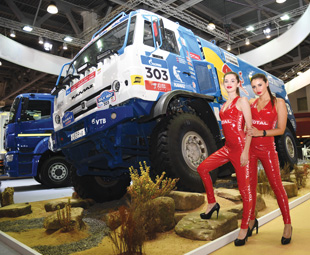 The formation of two separate companies wasn’t a great idea – and so they merged to form Daimler KAMAZ Rus, as Heiko Schulze, its chief executive officer, tells FOCUS. “Running two companies with two separate production facilities and lots of duplications just didn’t make sense – and so we merged the two in 2015, forming Daimler KAMAZ Rus.”
The formation of two separate companies wasn’t a great idea – and so they merged to form Daimler KAMAZ Rus, as Heiko Schulze, its chief executive officer, tells FOCUS. “Running two companies with two separate production facilities and lots of duplications just didn’t make sense – and so we merged the two in 2015, forming Daimler KAMAZ Rus.”
The company produces over 30 configurations of Mercedes-Benz trucks: Actros, Atego, Axor, Unimog, Zetros, and Fuso trucks at a plant in Naberezhnye Chelny, which is also home to KAMAZ. Daimler has a 15-percent share in KAMAZ.
Ford Otosan, the Turkish joint venture between Ford Motor Company and Koç Holding, is another company that recently set its sights on the Russian market.
“We entered the Russian market ten years ago. In 2014, we signed an agreement with Avtotor Holding of Russia to produce Ford Trucks branded vehicles. We believe that Russia is a very important truck market. In fact, we believe that it will soon be the biggest heavy commercial vehicle market in Europe,” Ercan Emrah Duman, director – international markets at Ford Trucks, tells FOCUS.
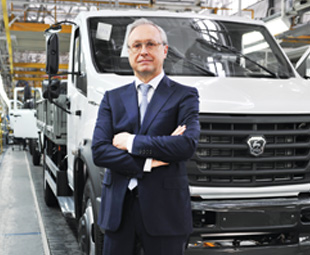 Competition among the European manufacturers – dubbed the B7 or the “Seven Sisters” – in the over six-tonne market has traditionally been tough. The Seven Sisters – Volvo, Scania, Mercedes-Benz, Renault, DAF, Iveco and MAN – have typically had to fight it out for the crumbs of the market while the Russian manufacturers have claimed the lion’s share.
Competition among the European manufacturers – dubbed the B7 or the “Seven Sisters” – in the over six-tonne market has traditionally been tough. The Seven Sisters – Volvo, Scania, Mercedes-Benz, Renault, DAF, Iveco and MAN – have typically had to fight it out for the crumbs of the market while the Russian manufacturers have claimed the lion’s share.
KAMAZ and GAZ are the undisputed market leaders in Russia. KAMAZ rules the roost when it comes to heavy commercial vehicle sector, while GAZ is the leader in the light and medium sectors. Both companies are players in the Russian bus market too (GAZ has an 80-percent share).
The two companies have dealers in all corners of the country: KAMAZ has 179 while GAZ has 220. “This may sound like a large number of dealers, but, for a country where you have 11 times zones, this isn’t too many. In addition to the number of dealers, customers can also buy spare parts for our vehicles in 1 843 shops across Russia,” Vadim Sorokin, GAZ group president, tells FOCUS.
Not surprisingly, KAMAZ and GAZ have achieved staggering market shares. In 2013, together they claimed 63 percent of the medium- and heavy-duty market (some other smaller Russian companies achieved a five-percent share, bringing the total share of Russian companies to 68 percent that year).
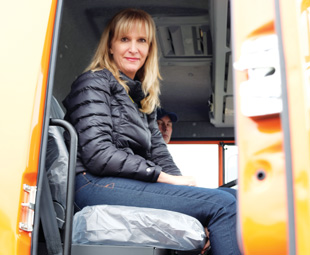 In 2014, the two market leaders claimed 65 percent, while Russian companies in total achieved 73 percent. In 2015, KAMAZ and GAZ achieved 66 percent; the total Russian share was 78 percent. Last year, the two dominant players achieved 67 percent and the smaller Russian companies achieved another ten percent, bringing the Russian share of market to a whopping 77 percent.
In 2014, the two market leaders claimed 65 percent, while Russian companies in total achieved 73 percent. In 2015, KAMAZ and GAZ achieved 66 percent; the total Russian share was 78 percent. Last year, the two dominant players achieved 67 percent and the smaller Russian companies achieved another ten percent, bringing the Russian share of market to a whopping 77 percent.
The Seven Sisters, the Asian companies (Japanese, Korean and Chinese truck makers) and the lone Turkish company have had to fight for the scraps that are left, but those scraps are slowly becoming more tantalising. In the first five months of this year, Russian companies enjoyed only 60 percent of the market. The Seven Sisters registered astronomical growth.
In the first quarter of 2017, Scania grew its sales by 146,7 percent, Volvo by 254,7 percent, Mercedes-Benz by 333,8 percent and DAF by 601,5 percent! Renault is showing remarkable growth too.
“Renault Trucks is the fastest-growing brand in the market among the B7,” claims commercial director of Renault Trucks Russia, Alexander Zori. “We have grown our sales by 900 percent in the first seven months of 2017 compared to the same period last year.”
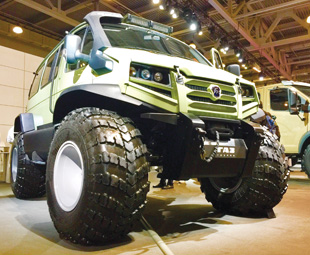 The growth of the Russian companies this year has been considerably more modest. KAMAZ sold 34 400 vehicles last year. This year, it anticipates selling 38 300 vehicles, of which 5 200 will be exported. It’s well on track to achieve this. Over the first nine months of 2017, for instance, KAMAZ produced 26 500 vehicle kits, which is 15-percent up on the period last year.
The growth of the Russian companies this year has been considerably more modest. KAMAZ sold 34 400 vehicles last year. This year, it anticipates selling 38 300 vehicles, of which 5 200 will be exported. It’s well on track to achieve this. Over the first nine months of 2017, for instance, KAMAZ produced 26 500 vehicle kits, which is 15-percent up on the period last year.
Why this astronomical growth?
Schulze explains that the growth in European truck sales can be attributed to two factors: the market is growing and so, too, is the B7’s share of this market. “We are seeing the total market growing for three reasons. First, there has been a slight recovery in the Russian economy. Second, many customers didn’t buy any vehicles in 2014 and 2015. They postponed purchasing decisions in order for their businesses to survive. Now they must purchase. Third, we are seeing a decline in small mom-and-pop companies. The Russian tax authority is clamping down on tax evasion and these companies are closing down as a result. Their contracts are going to larger companies, which are showing growth and buying lots of trucks.”
In September this year, 7 200 medium and heavy trucks were sold in Russia, which is 53,9-percent up on September 2016. The top-selling truck is typically a KAMAZ; in 2016, the KAMAZ 6511 was the best-selling truck in Russia (5 000 of these trucks were sold; the MAN TGS was the top-selling foreign truck last year, with 1 900 sales). However, in September 2017, the Volvo FH was top of the pops (537 units were sold which was 7,4-times more than in September 2016). Schulze believes that the B7 market (over six tonnes) will be 20 000 to 24 000 units this year while the total market will clock in at around 70 000 units.
KAMAZ focuses on larger vehicles. As such, Rafail Gafeev, general director of Foreign Trade Company KAMAZ, believes that the market for trucks with a gross vehicle mass (GVM) of 14 to 40 t will number 58 000 vehicles in 2017. “This is 44-percent more than in 2016. There is a positive trend in all segments of the truck market. The truck-tractor segment is growing the most,” he tells FOCUS.
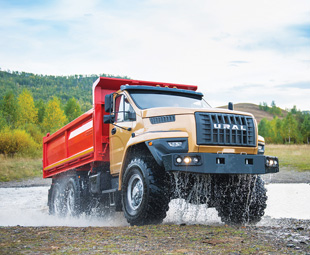 Gafeev attributes the growth to deferred demand, an increase in commercial cargo transportation, development of the oil and gas production sector, spending by housing and public utilities, stabilisation in the agricultural sector, and slackening of loan interest rates.
Gafeev attributes the growth to deferred demand, an increase in commercial cargo transportation, development of the oil and gas production sector, spending by housing and public utilities, stabilisation in the agricultural sector, and slackening of loan interest rates.
So, the market is growing – undoubtedly, but why the shift towards non-Russian products? The jury is out on this. One thing is certain, though: it has nothing to do with price. After all, from a pricing perspective, the Russian vehicles are typically the cheapest, the B7’s products are the most expensive and the Asian/Turkish products hover between the two warring parties.
Gafeev attributes the growth in sales by the Seven Sisters to currency fluctuations. “The B7 share is expected to reach 34 percent in 2017 (it was 26 percent in 2016). The sales of B7 vehicles are growing mainly thanks to the strengthening of the ruble,” he tells FOCUS.
Schulze disagrees. “International transporters, who are delivering just in time, cannot do this with a Russian truck. To them, reliability is vital. We have experienced the same sentiments among construction customers, who account for one third of our sales. With infrastructure projects, the construction trucks are running 24-hours a day and seven days a week because they must finish the project on time. They are penalised if they don’t meet deadlines; they are therefore selecting a premium truck,” he suggests.
 Scania’s Rowiński concurs. “Many Russian transport companies prefer European brands – they need efficient and reliable transport solutions with high-quality manufacturer support and a low operational cost. Operators want vehicles that are more fuel efficient and inexpensive to maintain. That’s why we are investing a lot in the Next Generation Scania: according to the telemetry from the first three vehicles, which were purchased by three major transport operators in August this year, fuel costs have declined by at least ten percent,” Rowiński explains.
Scania’s Rowiński concurs. “Many Russian transport companies prefer European brands – they need efficient and reliable transport solutions with high-quality manufacturer support and a low operational cost. Operators want vehicles that are more fuel efficient and inexpensive to maintain. That’s why we are investing a lot in the Next Generation Scania: according to the telemetry from the first three vehicles, which were purchased by three major transport operators in August this year, fuel costs have declined by at least ten percent,” Rowiński explains.
Ford’s Duman tells a similar story. “Russian customers have come to understand the benefits of low total cost of ownership (TCO). KAMAZ sells many vehicles because of its heritage and extensive dealer network, but we’re offering a lower TCO,” he adds.
Non-Russian companies upbeat
Given this shift in buying patterns, non-Russian companies are optimistic about the future. The Asian companies have only a very small share of market (ten percent at best) but Hino has announced that it will build a plant in the Moscow region. The new plant, which will be located in Khimki, will cost over one billion rubles (R243 million). The plant, which will open in 2019, will produce 2 000 Hino 300 and 500 Series trucks a year.
Renault Trucks, meanwhile, also has optimistic goals. “We want to achieve over six percent of the B7 market by 2020. Russia is an important market for Renault Trucks,” says Bruno Blen, president of Renault Trucks.
 Daimler KAMAZ Rus, on the other hand, wants to be number one in the B7 segment. “We have already assembled 20 000 trucks in total – 12 000 Mercedes-Benz and 8 000 Fuso trucks. It is our strategic aim to become number one among in the B7 sector. We accept that we will never beat KAMAZ; we can do what we want … we will never have a chance,” Schulze concedes.
Daimler KAMAZ Rus, on the other hand, wants to be number one in the B7 segment. “We have already assembled 20 000 trucks in total – 12 000 Mercedes-Benz and 8 000 Fuso trucks. It is our strategic aim to become number one among in the B7 sector. We accept that we will never beat KAMAZ; we can do what we want … we will never have a chance,” Schulze concedes.
The company is well on track to achieving this goal. “We are growing our share of the B7 market each year. In 2014, it was 14 percent. It will be over 20 percent this year. This will be the most successful year ever for Daimler Trucks in Russia. My personal guess is that we will end up number two in the B7 sector this year. Volvo is very strong at the moment; I don’t know if we will be able to overtake them,” says Schulze. In its quest to grow market share, Daimler KAMAZ Rus will open more dealerships – it has 46 at present, this will grow to 60.
Scania is growing its dealer network in Russia, too. “We are proud of our dealer network, which is located throughout Russia: from Kaliningrad to Vladivostok and currently encompasses 57 service stations. Despite our network’s broad coverage, we plan to develop it even further so that every client has the opportunity to purchase and appreciate our vehicles as conveniently as possible, regardless of their location or operational area,” says Rowiński.
Ford also wants to grow its market share. “We would like to achieve five percent of the typical B7 market,” Duman reveals. “This is not going to be easy. The Russian market is one of the most challenging in Europe, if not in the world. I say this because of the strength of the Russian brands, but it is a growing market. I anticipate that we will return to 100 000 annual sales by 2020,” he predicts.
Russian companies fight back
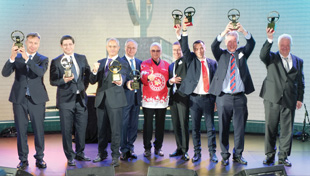 While the European, Turkish and Asian companies eye the Russian market, the local manufacturers won’t be standing around idly. They are fighting back and they have a two-pronged attack: products will be enhanced and exports will grow.
While the European, Turkish and Asian companies eye the Russian market, the local manufacturers won’t be standing around idly. They are fighting back and they have a two-pronged attack: products will be enhanced and exports will grow.
KAMAZ gave a tangible indication of this strategy at Comtrans, showing the new KAMAZ 54901. The cab of this new long-distance truck is based on the current Mercedes-Benz Actros and is to be produced in a new plant, currently being built by Daimler KAMAZ Rus.
The vehicle will be equipped with new KAMAZ P6 series inline six-cylinder Euro-5 and Euro-6 engines. (As an aside, the Euro-4 exhaust standard has been applicable in Russia since January 2012.) They will have an output of 283 to 410 kW (380 to 550 hp).
The new truck will feature ZF’s fully automatic Traxon transmission. KAMAZ also wants to offer numerous driver assistance systems in the new model. The truck will be launched in 2019.
Gafeev believes that this will curtail the growth in B7 sales. “The growth in B7 sales will be limited by two factors. First, in the next two years, the consensus forecast shows some weakening of the ruble, which will reduce the growth of the B7 share on the Russian market. Second, the new KAMAZ 54901– with its premium characteristics – will see our company grow market share,” he tells FOCUS.
GAZ is constantly enhancing its products and plants too. “We have just invested more than €500 million (about R8,29 billion) and have upgraded our facilities in Nizhny Novgorod. We have invested in new assembly and body shops, a new paint shop, and in improving logistics and the quality-control systems,” says Sorokin. FOCUS toured all these facilities; they truly are world class.
FOCUS was also able to test drive many of the latest GAZ models while in Russia and they appear very well put together; there were no rattles and shakes. The only thing missing in the vehicles we drove was an automatic transmission, but that’s coming soon. We drove diesel-powered vehicles, but GAZ also has an impressive range of gas-powered vehicles. It’s already developed driverless vehicles, which have yet to go into production.
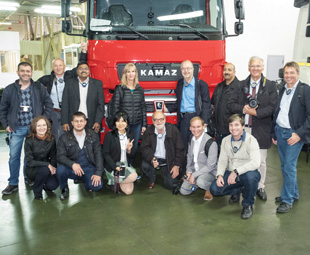 Electric vehicles are also on its radar, as Sorokin explains: “In the future, we will develop a model range of GAZ electric vehicles by creating a new component base, both in-house and jointly with specialised companies and scientific and technical centres. The main problem today is the high cost of basic electrical components, almost 100 percent of which are imported.
Electric vehicles are also on its radar, as Sorokin explains: “In the future, we will develop a model range of GAZ electric vehicles by creating a new component base, both in-house and jointly with specialised companies and scientific and technical centres. The main problem today is the high cost of basic electrical components, almost 100 percent of which are imported.
At present, GAZ Group – together with its partners – is developing an electric motor for light commercial vehicles with increased efficiency, batteries with their own control system and a number of other key components. We plan to start assembling new-generation electric vehicles by the end of this year.”
Eyeing exports
KAMAZ and GAZ both have ambitious export plans, which include South Africa. GAZ already supplies vehicles to Madagascar – the company opened a dealer there in 2016. This year, GAZ became a strategic partner of the Ministry of Education in Ghana, and it will sell more than 500 school buses to this country within the next five years.
“We also plan to export to other African countries, such as Zambia, Uganda, Tanzania and South Africa. These vehicles are capable of operating in extreme road conditions, under continuous maximum load and are adapted to different climatic conditions, while their low price and economical operation make them extremely desirable,” says Sorokin.
KAMAZ, on the other hand, will start delivering trucks to South Africa next year. “In cooperation with our distributor partner Bell Equipment, we plan to produce four dump-truck models in South Africa: 6×4 dump trucks with a payload of 15 and 20 t, as well as 8×4 and 6×6.1 models. Naturally they will be right-hand drive trucks. The first batch of trucks, produced in Russia for now, will be available for purchase in South Africa at the beginning of next year. Trucks assembled in Richards Bay will be received by customers in South Africa a little later. We are currently conducting preparatory work and completing tests there,” says Gafeev.
The 6×4 KAMAZ 65115 dump truck is an entry-level model equipped with a Cummins engine and a ZF9 gearbox. It is designed for operation on public roads, with a permissible maximum axle weight of ten tonnes.
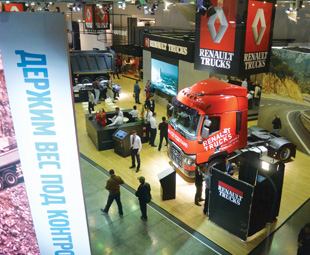 “The KAMAZ 6520 (6×4), KAMAZ 65222 (6×6.1) and KAMAZ 65201 (8×4) are equipped with a 300 kW (400 hp) KAMAZ 740.63-400 engine and a ZF16S1820 gearbox. They are designed for operation in quarries and on open roads,” he explains.
“The KAMAZ 6520 (6×4), KAMAZ 65222 (6×6.1) and KAMAZ 65201 (8×4) are equipped with a 300 kW (400 hp) KAMAZ 740.63-400 engine and a ZF16S1820 gearbox. They are designed for operation in quarries and on open roads,” he explains.
Gafeev says the Russian-built KAMAZ trucks destined for South Africa will have bodies produced at NEFAZ, a subsidiary of KAMAZ in Neftekamsk. “The Cummins engines are produced by Cummins KAMA, a joint venture in Russia. The transmissions will be produced in Russia by ZF KAMA, yet another joint venture,” he reveals.
According to Gafeev, KAMAZ vehicles can be found throughout Africa. “They are used to deliver humanitarian aid in Sudan, Southern Sudan, Uganda, Democratic Republic of Congo, Nigeria and Ghana. In 2018, we plan to supply more than 100 vehicles to Uganda and Ghana. They will be used by the United Nations. In addition, we have signed dealer agreements in 15 African countries this year, so we are confident that we will grow our market share on the African continent,” he says.
The final words go to the man known as “The Big Daddy of the Russian truck industry”: Sergey Kogogin, director-general of KAMAZ. “The role of the Russian manufacturers in the world truck industry is increasing. To a great extent, this is due to the growth of the Russian market; which is becoming one of the largest markets in the world. A key priority in the near future is to maintain and build upon the positions achieved in the domestic market. In the long term, Russian producers will focus on development of the emerging export markets,” he predicts.
The message is clear: the Russians are coming!
Published by
Focus on Transport
focusmagsa




